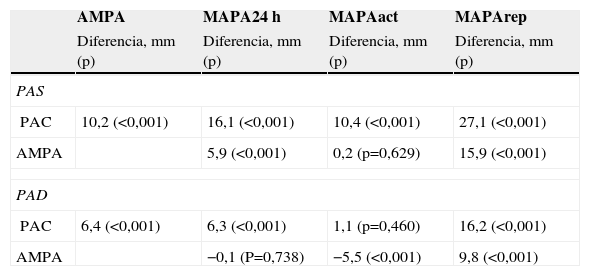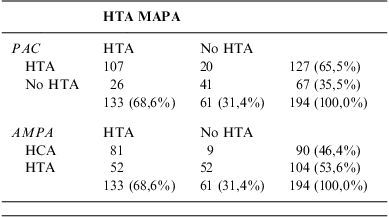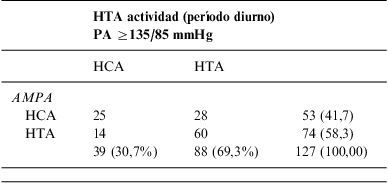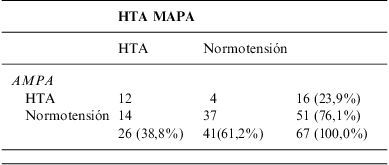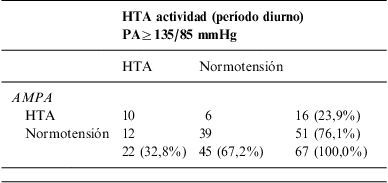El diagnóstico y control de la hipertensión arterial se sigue basando en la toma de presión arterial (PA) en consulta. Sin embargo, este procedimiento presenta limitaciones, por lo que se está generalizando en atención primaria el uso de la automedida de la presión arterial (AMPA). Nos planteamos estudiar la validez de esta técnica en el diagnóstico de hipertensión y en la detección de las situaciones de hipertensión clínica aislada e hipertensión enmascarada.
MétodosEstudiamos 194 pacientes, con y sin diagnóstico previo de hipertensión. A todos ellos se les midió la PA en consulta, se les realizó una monitorización de la PA durante 48h y finalmente una AMPA en domicilio.
ResultadosLa AMPA presenta una especificidad de 0,85 o 0,76 (dependiendo del parámetro de monitorización ambulatoria de la presión arterial considerado como patrón oro) en el diagnóstico de hipertensión, mayor que la que presenta la toma de PA en consulta (0,65/0,54). La sensibilidad de la AMPA (0,62/0,64) es menor que la de la toma de PA clínica (0,81/0,80).
La AMPA tiene para el diagnóstico de hipertensión clínica aislada una moderada sensibilidad (0,75/0,64) y especificidad (0,65/0,68), un alto valor predictivo negativo (0,93/0,81), un bajo valor predictivo positivo (0,28/0,47) y unos pobres coeficientes de probabilidad (positivo: 2,32/2,01; negativo: 0,39/0,53).
La AMPA tiene una alta especificidad (0,90/0,87), unos moderados valores predictivos (positivo: 0,75/0,63; negativo: 0,73/0,76) y un moderado coeficiente de probabilidad positivo (4,73/3,41) para el diagnóstico de hipertensión arterial enmascarada.
ConclusionesLa AMPA es un complemento para el diagnóstico y seguimiento de nuestros pacientes en el primer nivel de la atención sanitaria, pero debemos ser cautos en lo que nos puede ofrecer.
Diagnosis and control of high blood pressure are still based on measuring blood pressure in the doctor's office. However, this procedure has limitations, so that the use of self-measurement of blood pressure is becoming generalized in primary care. We have proposed the study of the validity of this technique in the diagnosis of high blood pressure and in the detection of the situations of isolated and masked hypertension.
MethodsWe studied 194 patients, with and without previous diagnosis of high blood pressure. Blood pressure was measured for all of them in the doctor's office and 48-hour monitoring of the blood pressure was performed. Finally self-measurement of blood pressure was done in the home.
ResultsABPM showed a specificity of 0.85 or 0.76 (depending on the ABPM parameter considered as gold standard) in the diagnosis of high blood pressure. This was higher than that found when the blood pressure was obtained in the doctor's office (0.65/0.54). Sensitivity of the ABPM (0.62/0.64) is lower than when the BP is obtained in the doctor's office (0.81/0.80)
ABPM has a moderate sensitivity (0.75/0.64) and specificity (0.65/0.68), high negative predictive value (0.93/0.81), with low positive predictive value (0.28/0.47) and poor likelihood coefficients (PPC 2.32/2.01–NPC 0.39/0.53) for the diagnosis of isolated hypertension.
ABPM has high specificity (0.90/0.87), moderate predictive values (PPV 0.75/0.63, NPV 0.73/0.76) and moderate positive likelihood coefficient (4.73/3.41), for the diagnosis of masked hypertension.
ConclusionsABPM is a complement to the diagnosis and follow-up of our patients in the first level of health care, but we should be cautious regarding what it can offer us.
Artículo
Comprando el artículo el PDF del mismo podrá ser descargado
Precio 19,34 €
Comprar ahora







